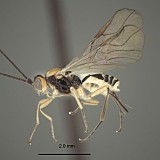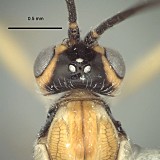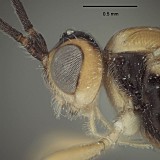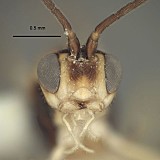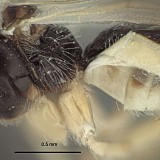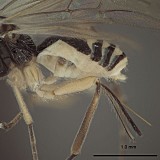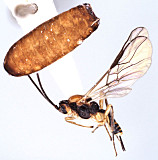Opius pipitae Wharton, 2013
Holotype: Female, deposited in UNAM.
Three species are included in the Opius pipitae species group: O. pipitae, O. stecki , and O. townesi. These species will key to either Pendopius or Opiothorax in the subgeneric classification of Fischer (1972, 1977) and to Adontopius Fischer in Fischer (1999). In Li et al. (2013), they key to Phaedrotoma. In members of the pipitae species group, the vertical carina on the pronotum laterally is very well developed and the pleural sulcus is distinct both anterior and posterior to the propodeal spiracle.
Opius pipitae is much lighter in color than O. stecki . The mesosoma is completely dark in the latter species. The pronotum laterally also has a little more sculpture medially in O. pipitae than in O. stecki . Opius pipitae is very similar to O. townesi, a previously described species for which no host information is available. Opius townesi is smaller, with significantly fewer flagellomeres (30), is slightly darker, without the pale orbital ring dorsally, and T1 is not as heavily sculptured. Although Fischer (1977) placed O. townesi in the subgenus Opius, the labrum is exposed in the small but distinct gap between the ventral margin of the clypeus and the dorsal margin of the mandibles. Opius townesi is therefore included in the pipitae species group as defined here. Opius townesi was described from Maryland (USA).
One specimen of O. gabriellae was reared from a species of Neotephritis infesting flower heads of his same host plant.
There are no specimens currently determined for this OTU, or those specimens determined for this OTU are not yet mappable.
MEXICO: Morelos
Huitzilac, 22.IX.
1991, A.L.Norrbom
Second label:
reared ex. lateral
stem gall on Montanoa
frutescens (91M5A)
Third label:
ex. Tephritidae
n. gen., n. sp.
The date on the holotype label and one of the female paratypes was incorrectly given as 22.X in the original description of this species. The correct date is 22.IX
This material is based upon work supported by the National Science Foundation under Grant Numbers DEB 0949027 and DEB 0328922 with REU supplement 1313933.
Any opinions, findings, and conclusions or recommendations expressed in this material are those of the author(s) and do not necessarily reflect the views of the National Science Foundation.

